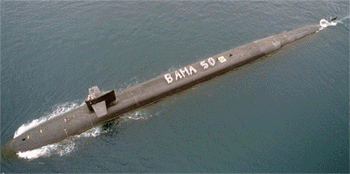The Physics of Submarines
By Nathan EarlsUniversity of Alaska Fairbanks
Web Project for Physics 212 Spring 2003

Photo courtesy of: Submarine World
Welcome to my web page on submarines. I hope
to explain to you a little bit about the way submarines work. They are
very complicated machines, and to try and cover every aspect in detail would
be pretty overwhelming. So I am going to touch on a few of the concepts
about submarines that I find the most interesting: propulsion, surfacing
and diving, and sonar.
Submarines have been around for longer than most people think. The first American attempts at creating a submersible boat date back to the days of the Revolutionary and Civil Wars. These boats, however, turned out to be just as dangerous to the people on board as they were to the enemy boats. So the concept was put aside for a while. But in the 1890's two men named John Holland and Simon Lake built a practical underwater boat. The US Navy bought its first submarine from Mr. Holland on April 11, 1900, a date which is thought of as the birthday of the US submarine force. Submarines progressed in technology throughout the years and were used extensively and quite successfully in both world wars. The major breakthrough in submarine technology came in the next ten years after the war, when nuclear propulsion was developed. This is one of the topics that will be discussed in greater detail later.
Submarines have been around for longer than most people think. The first American attempts at creating a submersible boat date back to the days of the Revolutionary and Civil Wars. These boats, however, turned out to be just as dangerous to the people on board as they were to the enemy boats. So the concept was put aside for a while. But in the 1890's two men named John Holland and Simon Lake built a practical underwater boat. The US Navy bought its first submarine from Mr. Holland on April 11, 1900, a date which is thought of as the birthday of the US submarine force. Submarines progressed in technology throughout the years and were used extensively and quite successfully in both world wars. The major breakthrough in submarine technology came in the next ten years after the war, when nuclear propulsion was developed. This is one of the topics that will be discussed in greater detail later.
These links are to the other pages which contain
more specific information about each subject:
Propulsion
Surfacing and Diving
Sonar
Bibliography
Propulsion
Surfacing and Diving
Sonar
Bibliography